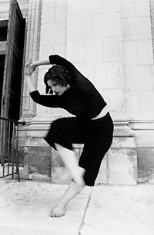When people talk about Alexandra Beller, the word "goddess" comes up a lot.
Beller is "built like a burlesque queen and moves like a goddess," writes Dance Magazine's Joseph Carman. She's a "dance goddess ... a woman of substance who moves like mercury," said Mira Kingsley in MODE Magazine. And Tobi Tobias of New York magazine said of Beller, "While her anatomy leads you to expect an earth goddess--weighty and rooted--she's quick, light and buoyant, with a mercurial liquidity in her joints."
A dancer/choreographer and former member of the Bill T. Jones/Arnie Zane Dance Company, Beller is in residence at MIT intermittently through Sept. 28. On Monday, Sept. 22, she will give a talk titled "The Dancing Body" at 4 p.m. in Kresge Little Theater, in which she will discuss the barriers between truth and fiction and gender structures which dictate behavior, particularly woman's behavior.
Beller has performed in more than 50 countries. She has been a featured dancer in "Max Roach's America" and was the collaborator and subject of a series of photographs by Irving Penn titled "Dancer," exhibited at the Whitney Museum in 2002.
Beller also will work with MIT's Dance Theater Ensemble during her time at MIT. The group will perform "Clich� Soup," choreographed by Beller, on Sunday, Sept. 28 at 1 p.m. in the Lipchitz Courtyard in Building 14.
"Clich� Soup" investigates how "something new turns into something expected and how it can turn into the unexpected," says Beller. She notes that while the dance won't have a narrative structure, it may offer a "metaphorical suggestion" for the audience.
The piece will be performed to a musical composition by Mike Fabio, a senior in music. His work is a "largely electronic piece that twists well-known pieces into something strange and new," he said. "I'm excited to explore the geometries of sound space as it relates to human movement."
For more information, call 253-4720.
A version of this article appeared in MIT Tech Talk on September 17, 2003.






